brake YAMAHA WR 400F 2000 Manuale duso (in Italian)
[x] Cancel search | Manufacturer: YAMAHA, Model Year: 2000, Model line: WR 400F, Model: YAMAHA WR 400F 2000Pages: 654, PDF Dimensioni: 60.12 MB
Page 150 of 654
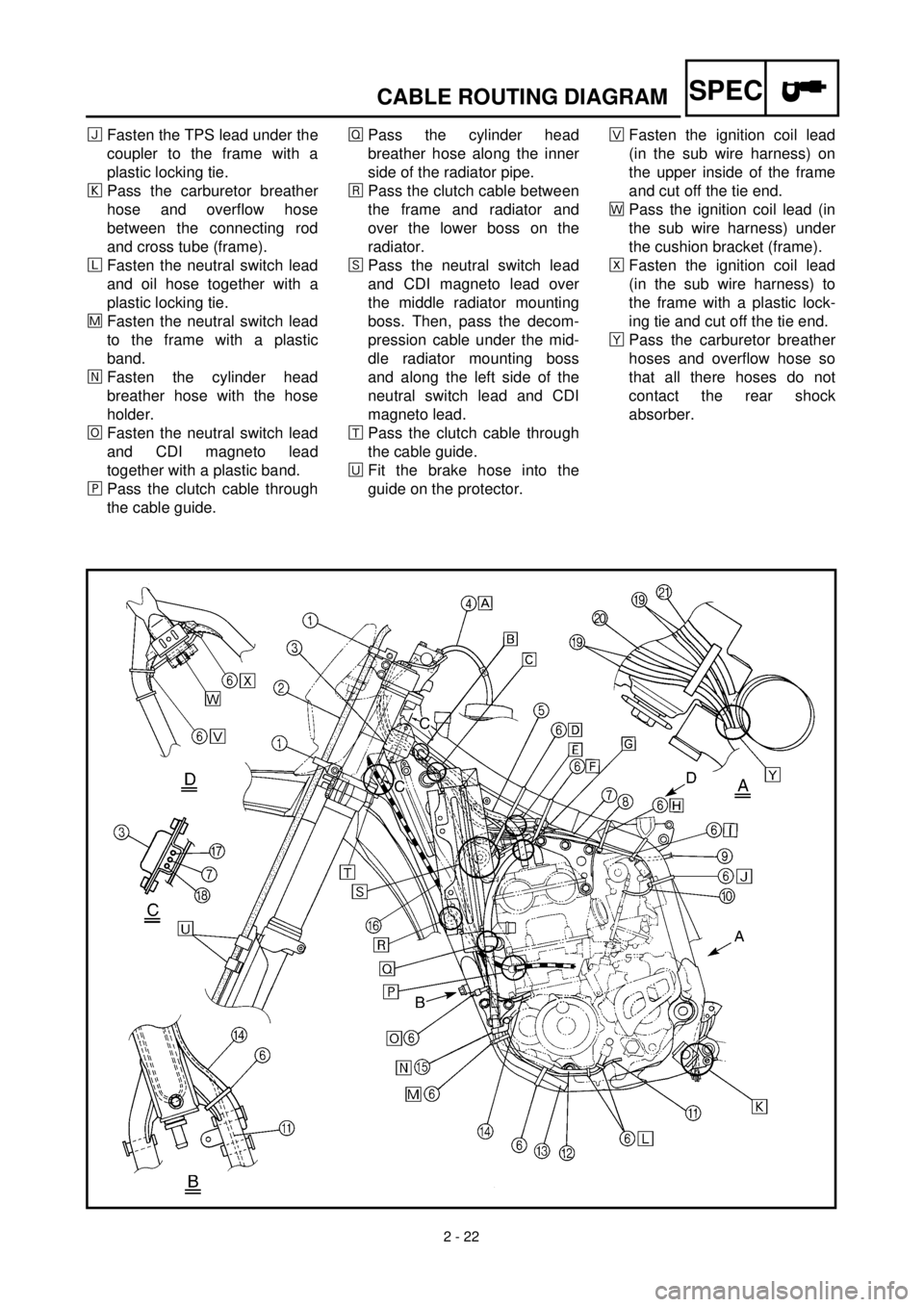
2 - 22
SPECCABLE ROUTING DIAGRAM
ïFasten the TPS lead under the
coupler to the frame with a
plastic locking tie.
ðPass the carburetor breather
hose and overflow hose
between the connecting rod
and cross tube (frame).
ñFasten the neutral switch lead
and oil hose together with a
plastic locking tie.
÷Fasten the neutral switch lead
to the frame with a plastic
band.
öFasten the cylinder head
breather hose with the hose
holder.
¯Fasten the neutral switch lead
and CDI magneto lead
together with a plastic band.
¸Pass the clutch cable through
the cable guide.ÎPass the cylinder head
breather hose along the inner
side of the radiator pipe.
åPass the clutch cable between
the frame and radiator and
over the lower boss on the
radiator.
êPass the neutral switch lead
and CDI magneto lead over
the middle radiator mounting
boss. Then, pass the decom-
pression cable under the mid-
dle radiator mounting boss
and along the left side of the
neutral switch lead and CDI
magneto lead.
æPass the clutch cable through
the cable guide.
èFit the brake hose into the
guide on the protector.×Fasten the ignition coil lead
(in the sub wire harness) on
the upper inside of the frame
and cut off the tie end.
ãPass the ignition coil lead (in
the sub wire harness) under
the cushion bracket (frame).
ÅFasten the ignition coil lead
(in the sub wire harness) to
the frame with a plastic lock-
ing tie and cut off the tie end.
çPass the carburetor breather
hoses and overflow hose so
that all there hoses do not
contact the rear shock
absorber.
Page 154 of 654
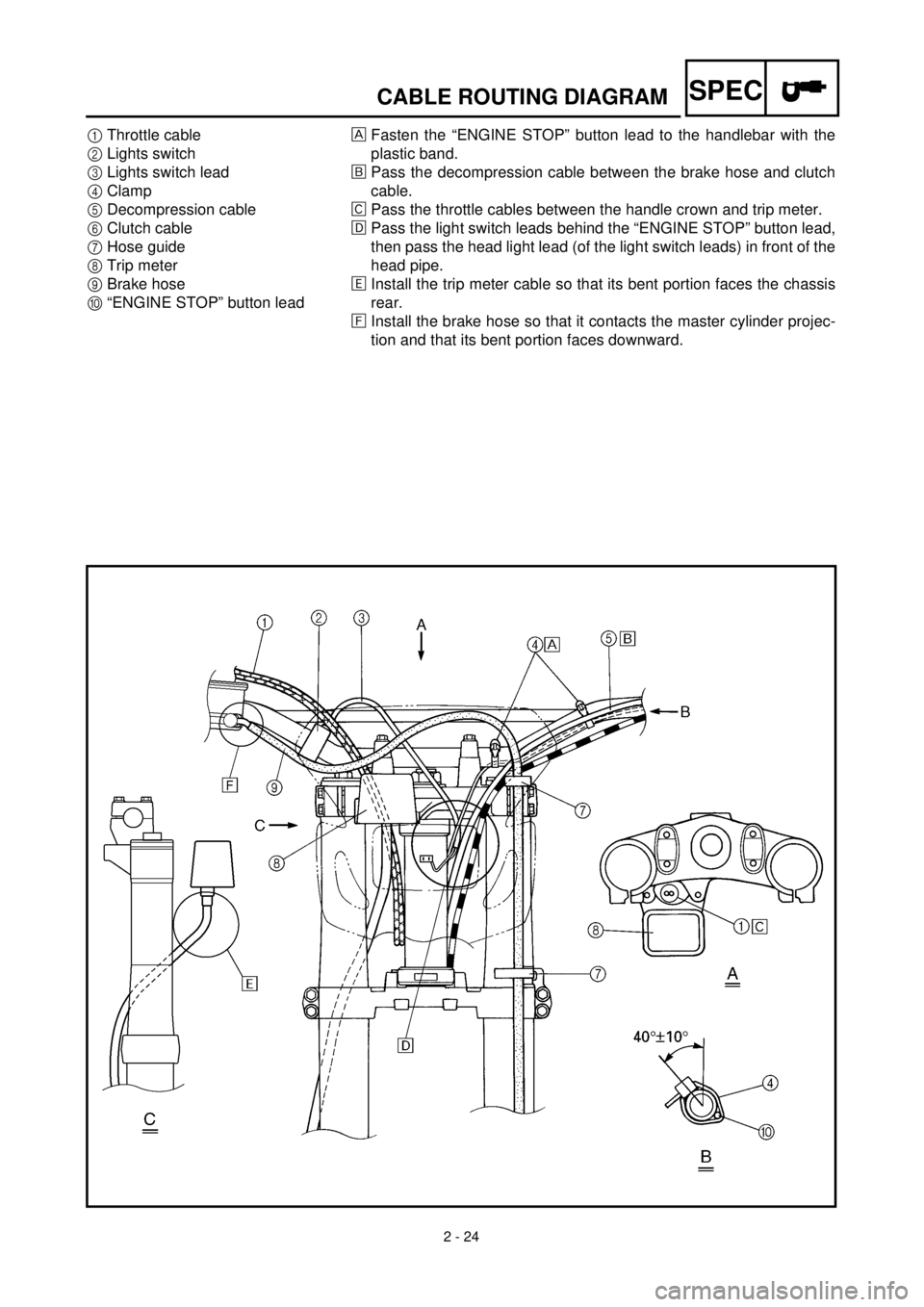
2 - 24
SPECCABLE ROUTING DIAGRAM
1Throttle cable
2Lights switch
3Lights switch lead
4Clamp
5Decompression cable
6Clutch cable
7Hose guide
8Trip meter
9Brake hose
0“ENGINE STOP” button leadFasten the “ENGINE STOP” button lead to the handlebar with the
plastic band.
õPass the decompression cable between the brake hose and clutch
cable.
‚Pass the throttle cables between the handle crown and trip meter.
ëPass the light switch leads behind the “ENGINE STOP” button lead,
then pass the head light lead (of the light switch leads) in front of the
head pipe.
äInstall the trip meter cable so that its bent portion faces the chassis
rear.
ìInstall the brake hose so that it contacts the master cylinder projec-
tion and that its bent portion faces downward.
Page 157 of 654

3 - 2
INSP
ADJ
MAINTENANCE INTERVALS
SHIFT FORK, SHIFT CAM, GUIDE BAR
Inspect
c
Inspect wear
ROTOR NUT
Retighten
cc
MUFFLER
Inspect
Clean
Replace
Retighten
cc
ccc
*Whichever comes first
CRANK
Inspect and clean
cc
CARBURETOR
Inspect, adjust and clean
cc
When using a high-pres-
sure washer, make sure
that water does not enter
the accelerator pump.
SPARK PLUG
Inspect and clean
Replace
cc
c
DRIVE CHAIN
Lubricate, slack, alignment
Replace
cc
c
Use chain lube
Chain slack: 40 ~ 50 mm
(1.6 ~ 2.0 in)
COOLING SYSTEM
Check coolant level and leakage
Check radiator cap operation
Replace coolant
Inspect hoses
cc
cc
c
Every two years
OUTSIDE NUTS AND BOLTS
Retighten
cc
Refer to “STARTING AND
BREAK-IN” section in the
CHAPTER 1.
AIR FILTER
Clean and lubricate
Replace
cc
c
Use foam air-filter oil
OIL STRAINER (frame)
Clean
c
FRAME
Clean and inspect
cc
FUEL TANK, COCK
Clean and inspect
cc
BRAKES
Adjust lever position and pedal height
Lubricate pivot point
Check brake disc surface
Check fluid level and leakage
Retighten brake disc bolts, caliper
bolts, master cylinder bolts and union
bolts
Replace pads
Replace brake fluid
c
c
c
c
cc
c
c
c
c
c
c
Every one year
FRONT FORKS
Inspect and adjust
Replace oil
Replace oil seal
c
cc
c
c
Suspension oil “01” ItemAfter
break-inEvery
race
Every
third
(or
500 km)Every
fifth
(or
1,000 km)
As re-
quiredRemarks
3
Page 168 of 654

3 - 4
INSP
ADJ
PRE-OPERATION INSPECTION AND MAINTENANCE
EC320000
PRE-OPERATION INSPECTION AND MAINTENANCE
Before riding for break-in operation, practice or a race, make sure the machine is in good operating
condition.
Before using this machine, check the following points.
GENERAL INSPECTION AND MAINTENANCE
Item Routine Page
CoolantCheck that coolant is filled up to the radiator filler cap.
Check that the coolant level is correct in the coolant reservoir
tank.
Check the cooling system for leakage.P.3-5 ~ 9
FuelCheck that a fresh gasoline is filled in the fuel tank. Check the
fuel line for leakage.P.1-12
Engine oilCheck that the oil level is correct. Check the crankcase and
frame oil line for leakage.P.3-13 ~ 17
Gear shifter and clutchCheck that gears can be shifted correctly in order and that the
clutch operates smoothly.P.3-9
Throttle grip/HousingCheck that the throttle grip operation and free play are correctly
adjusted. Lubricate the throttle grip and housing, if necessary.P.3-10 ~ 11
Brakes Check the play of front brake and effect of front and rear brake. P.3-25 ~ 31
ChainCheck chain slack and alignment. Check that the chain is lubri-
cated properly.P.3-32 ~ 34
WheelsCheck for excessive wear and tire pressure. Check for loose
spokes and have no excessive play.P.3-42 ~ 43
SteeringCheck that the handlebar can be turned smoothly and have no
excessive play.P.3-43 ~ 44
Front forks and rear shock
absorberCheck that they operate smoothly and there is no oil leakage. P.3-34 ~ 41
Cables (wires)Check that the clutch and throttle cables move smoothly. Check
that they are not caught when the handlebars are turned or
when the front forks travel up and down.—
Muffler Check that the muffler is tightly mounted and has no cracks. P.4-2
Sprocket Check that the driven sprocket tightening bolt is not loose. P.3-32
Lubrication Check for smooth operation. Lubricate if necessary. P.3-45
Bolts and nuts Check the chassis and engine for loose bolts and nuts. P.1-17
Lead connectorsCheck that the CDI magneto, CDI unit, and ignition coil are con-
nected tightly.P.1-5
SettingsIs the machine set suitably for the condition of the racing course
and weather or by taking into account the results of test runs
before racing? Are inspection and maintenance completely
done?P.7-1 ~ 21
Page 214 of 654
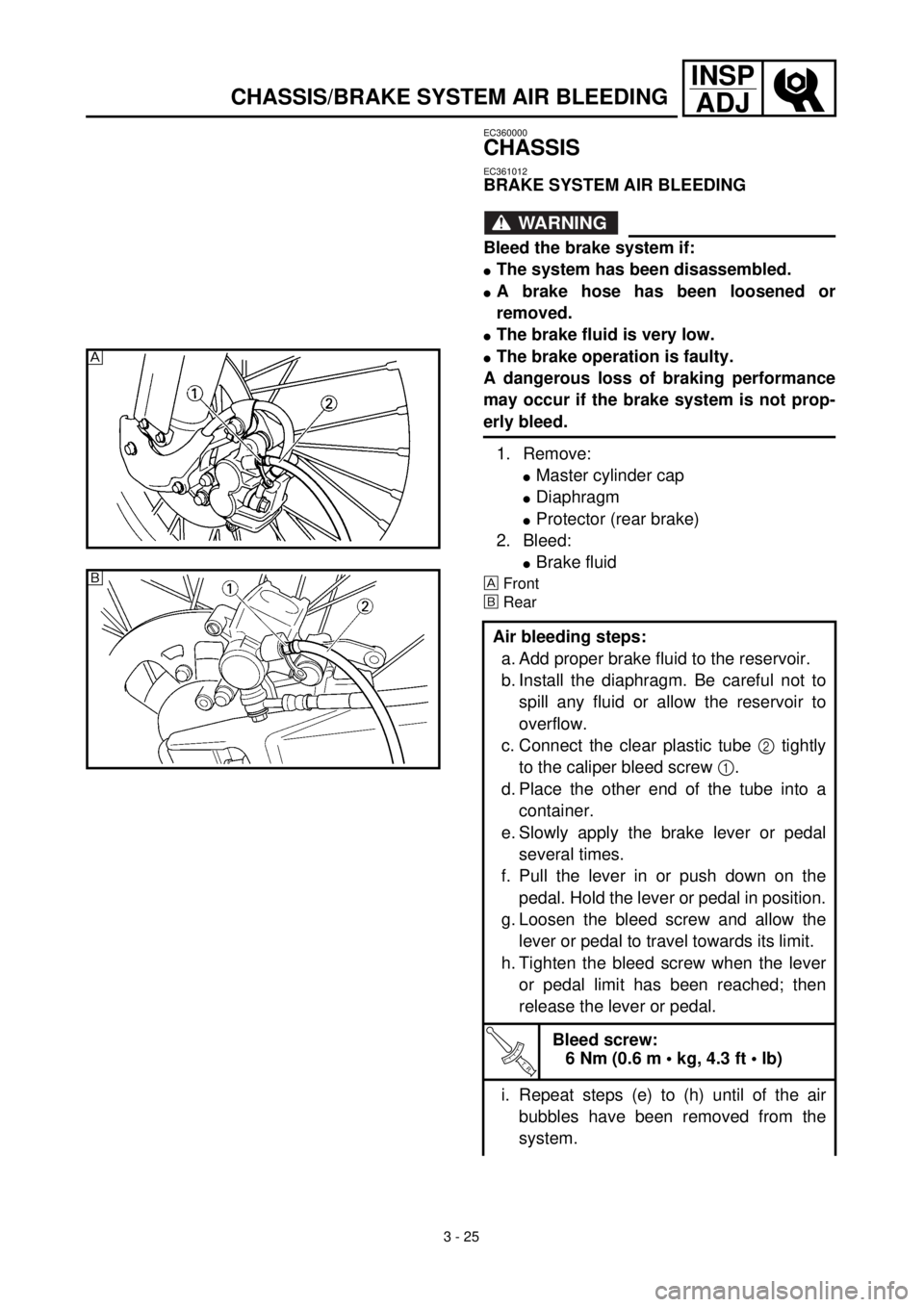
3 - 25
INSP
ADJ
CHASSIS/BRAKE SYSTEM AIR BLEEDING
EC360000
CHASSIS
EC361012
BRAKE SYSTEM AIR BLEEDING
WARNING
Bleed the brake system if:
lThe system has been disassembled.
lA brake hose has been loosened or
removed.
lThe brake fluid is very low.
lThe brake operation is faulty.
A dangerous loss of braking performance
may occur if the brake system is not prop-
erly bleed.
1. Remove:
lMaster cylinder cap
lDiaphragm
lProtector (rear brake)
2. Bleed:
lBrake fluid
Front
õRear
Air bleeding steps:
a. Add proper brake fluid to the reservoir.
b. Install the diaphragm. Be careful not to
spill any fluid or allow the reservoir to
overflow.
c. Connect the clear plastic tube 2 tightly
to the caliper bleed screw 1.
d. Place the other end of the tube into a
container.
e. Slowly apply the brake lever or pedal
several times.
f. Pull the lever in or push down on the
pedal. Hold the lever or pedal in position.
g. Loosen the bleed screw and allow the
lever or pedal to travel towards its limit.
h. Tighten the bleed screw when the lever
or pedal limit has been reached; then
release the lever or pedal.
T R..
Bleed screw:
6 Nm (0.6 m • kg, 4.3 ft • lb)
i. Repeat steps (e) to (h) until of the air
bubbles have been removed from the
system.
õ
Page 216 of 654
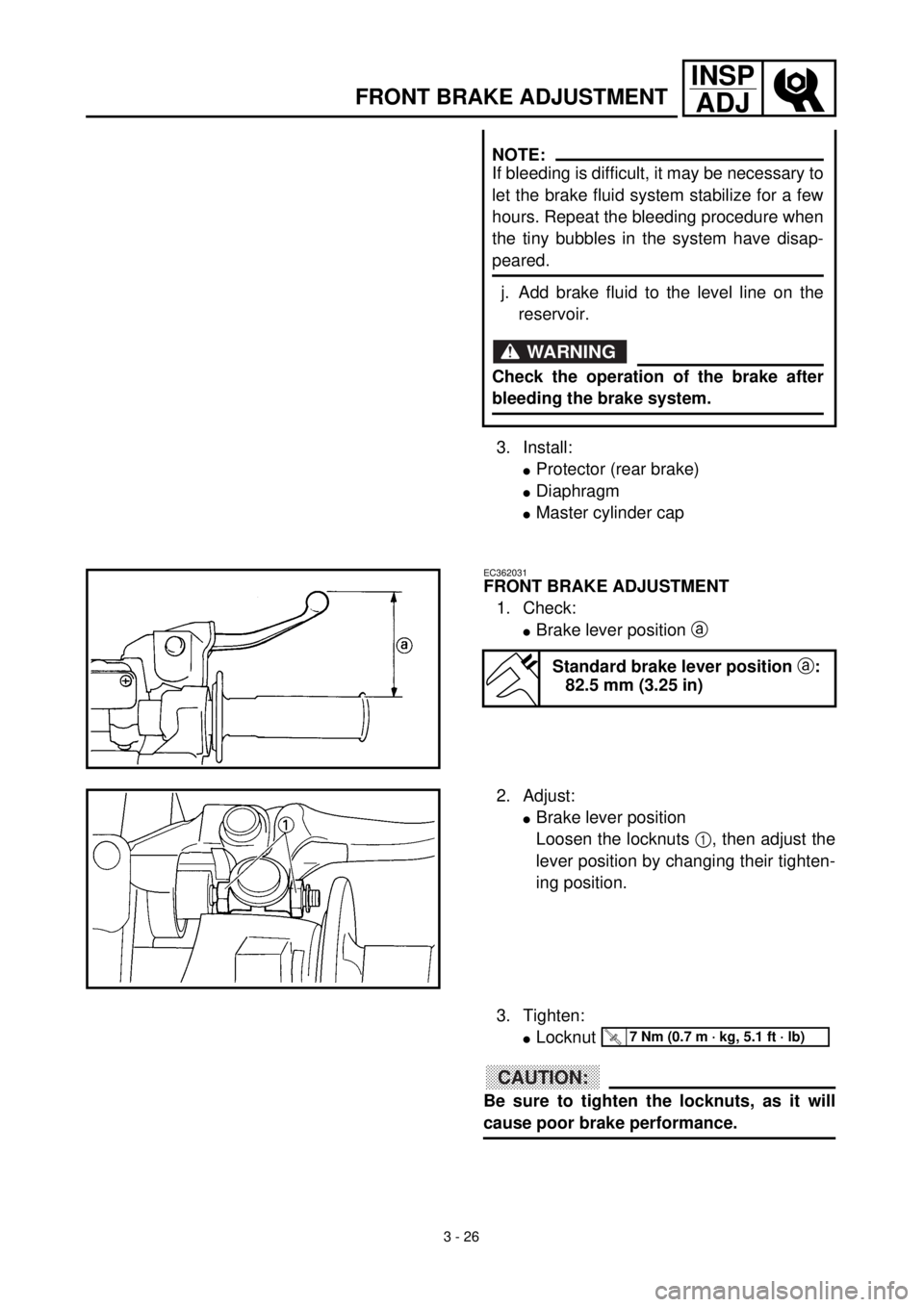
3 - 26
INSP
ADJ
FRONT BRAKE ADJUSTMENT
3. Install:
lProtector (rear brake)
lDiaphragm
lMaster cylinder cap
NOTE:
If bleeding is difficult, it may be necessary to
let the brake fluid system stabilize for a few
hours. Repeat the bleeding procedure when
the tiny bubbles in the system have disap-
peared.
j. Add brake fluid to the level line on the
reservoir.
WARNING
Check the operation of the brake after
bleeding the brake system.
EC362031
FRONT BRAKE ADJUSTMENT
1. Check:
lBrake lever position a
Standard brake lever position a:
82.5 mm (3.25 in)
2. Adjust:
lBrake lever position
Loosen the locknuts 1, then adjust the
lever position by changing their tighten-
ing position.
3. Tighten:
lLocknut
CAUTION:
Be sure to tighten the locknuts, as it will
cause poor brake performance.
T R..7 Nm (0.7 m · kg, 5.1 ft · lb)
Page 218 of 654
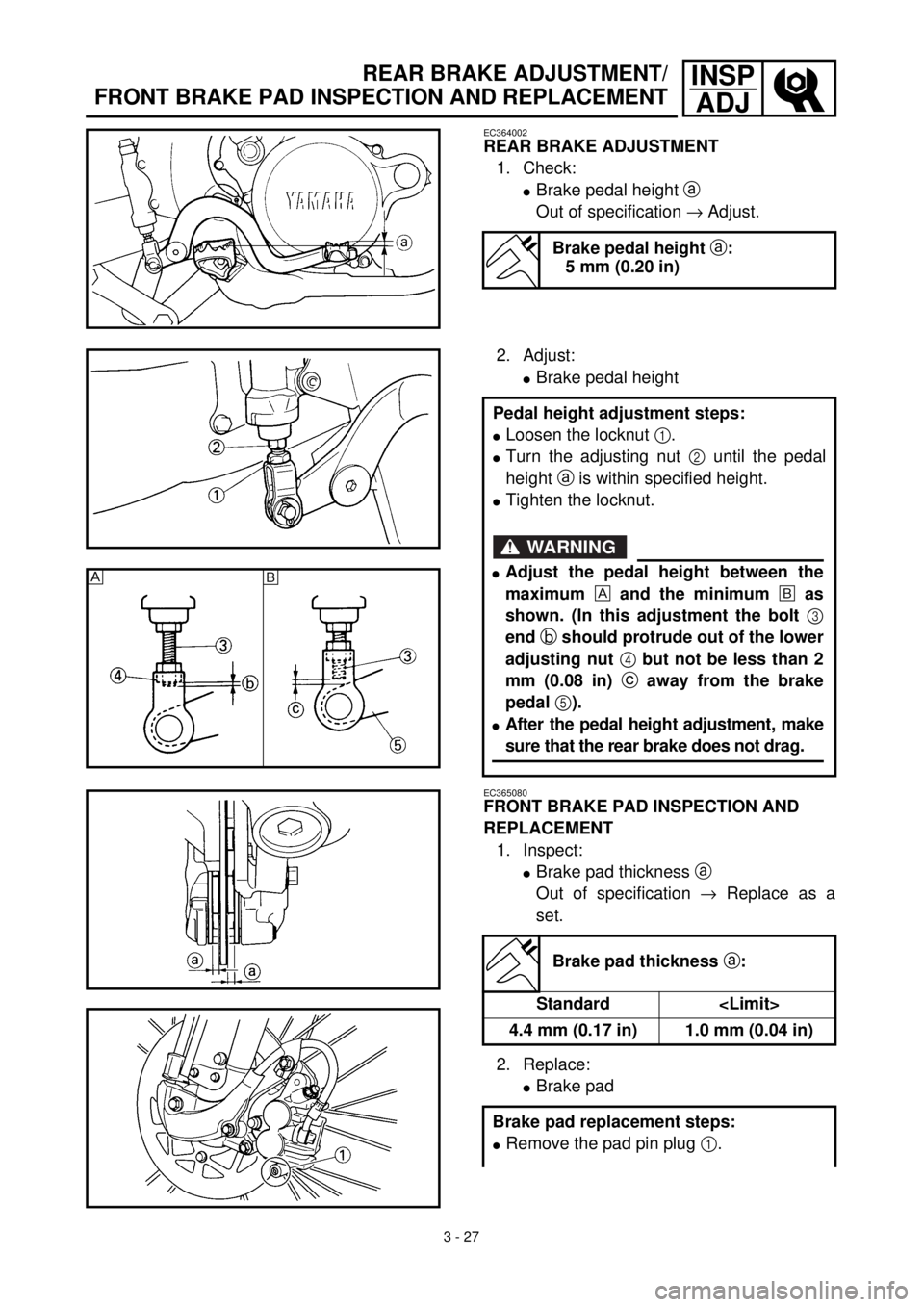
3 - 27
INSP
ADJREAR BRAKE ADJUSTMENT/
FRONT BRAKE PAD INSPECTION AND REPLACEMENT
EC364002
REAR BRAKE ADJUSTMENT
1. Check:
lBrake pedal height a
Out of specification ® Adjust.
Brake pedal height a:
5 mm (0.20 in)
2. Adjust:
lBrake pedal height
EC365080
FRONT BRAKE PAD INSPECTION AND
REPLACEMENT
1. Inspect:
lBrake pad thickness a
Out of specification ® Replace as a
set.
2. Replace:
lBrake pad Pedal height adjustment steps:
lLoosen the locknut 1.
lTurn the adjusting nut 2 until the pedal
height a is within specified height.
lTighten the locknut.
Brake pad thickness a:
Standard
4.4 mm (0.17 in) 1.0 mm (0.04 in)
Brake pad replacement steps:
lRemove the pad pin plug 1.
õ
WARNING
lAdjust the pedal height between the
maximum and the minimum õ as
shown. (In this adjustment the bolt 3
end b should protrude out of the lower
adjusting nut 4 but not be less than 2
mm (0.08 in) c away from the brake
pedal 5).
lAfter the pedal height adjustment, make
sure that the rear brake does not drag.
Page 220 of 654
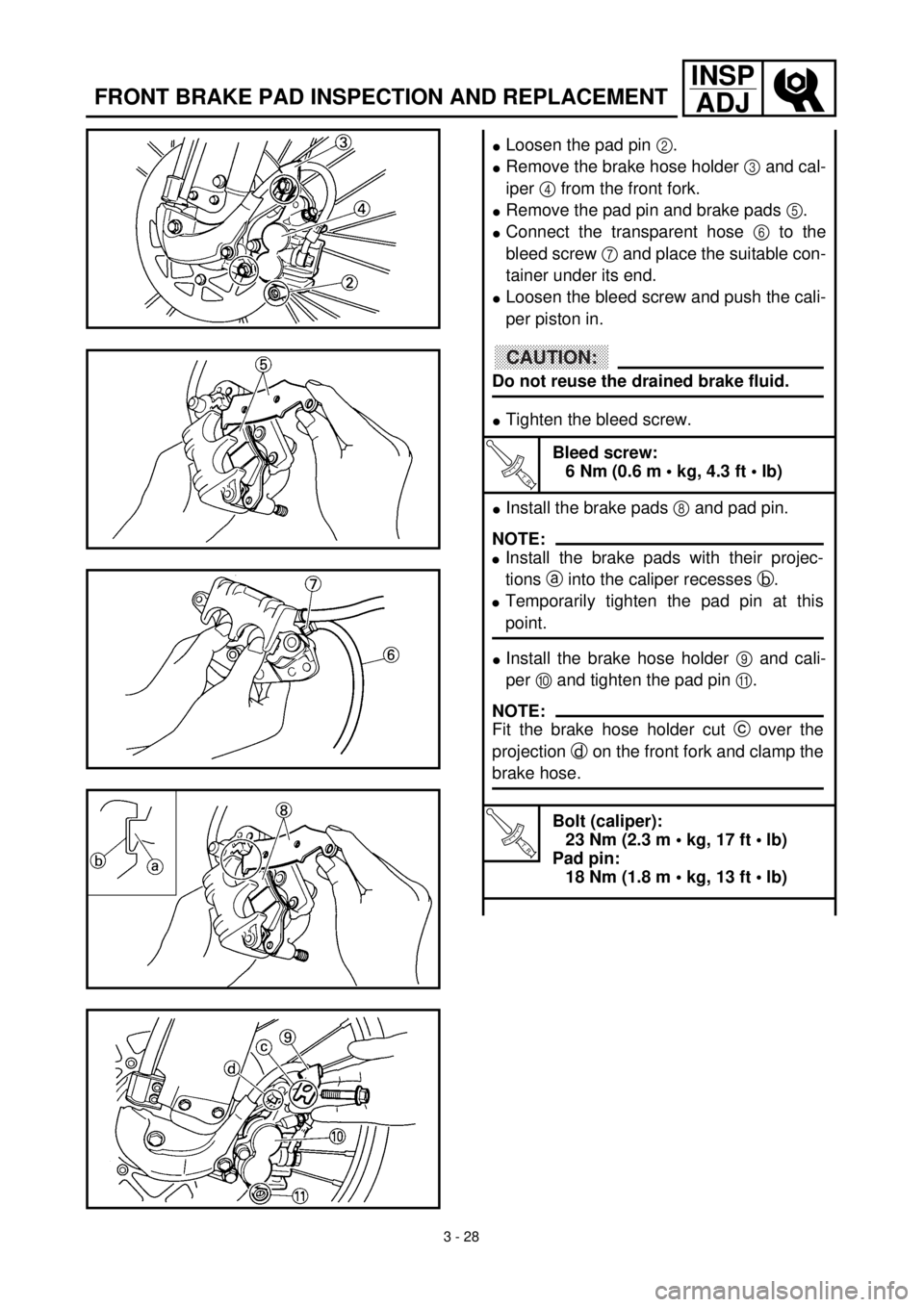
3 - 28
INSP
ADJ
FRONT BRAKE PAD INSPECTION AND REPLACEMENT
lLoosen the pad pin 2.
lRemove the brake hose holder 3 and cal-
iper 4 from the front fork.
lRemove the pad pin and brake pads 5.
lConnect the transparent hose 6 to the
bleed screw 7 and place the suitable con-
tainer under its end.
lLoosen the bleed screw and push the cali-
per piston in.
lTighten the bleed screw.
T R..
Bleed screw:
6 Nm (0.6 m • kg, 4.3 ft • lb)
lInstall the brake pads 8 and pad pin.
lInstall the brake hose holder 9 and cali-
per 0 and tighten the pad pin A.
T R..
Bolt (caliper):
23 Nm (2.3 m • kg, 17 ft • lb)
Pad pin:
18 Nm (1.8 m • kg, 13 ft • lb)
CAUTION:
Do not reuse the drained brake fluid.
NOTE:
lInstall the brake pads with their projec-
tions a into the caliper recesses b.
lTemporarily tighten the pad pin at this
point.
NOTE:
Fit the brake hose holder cut c over the
projection d on the front fork and clamp the
brake hose.
Page 222 of 654
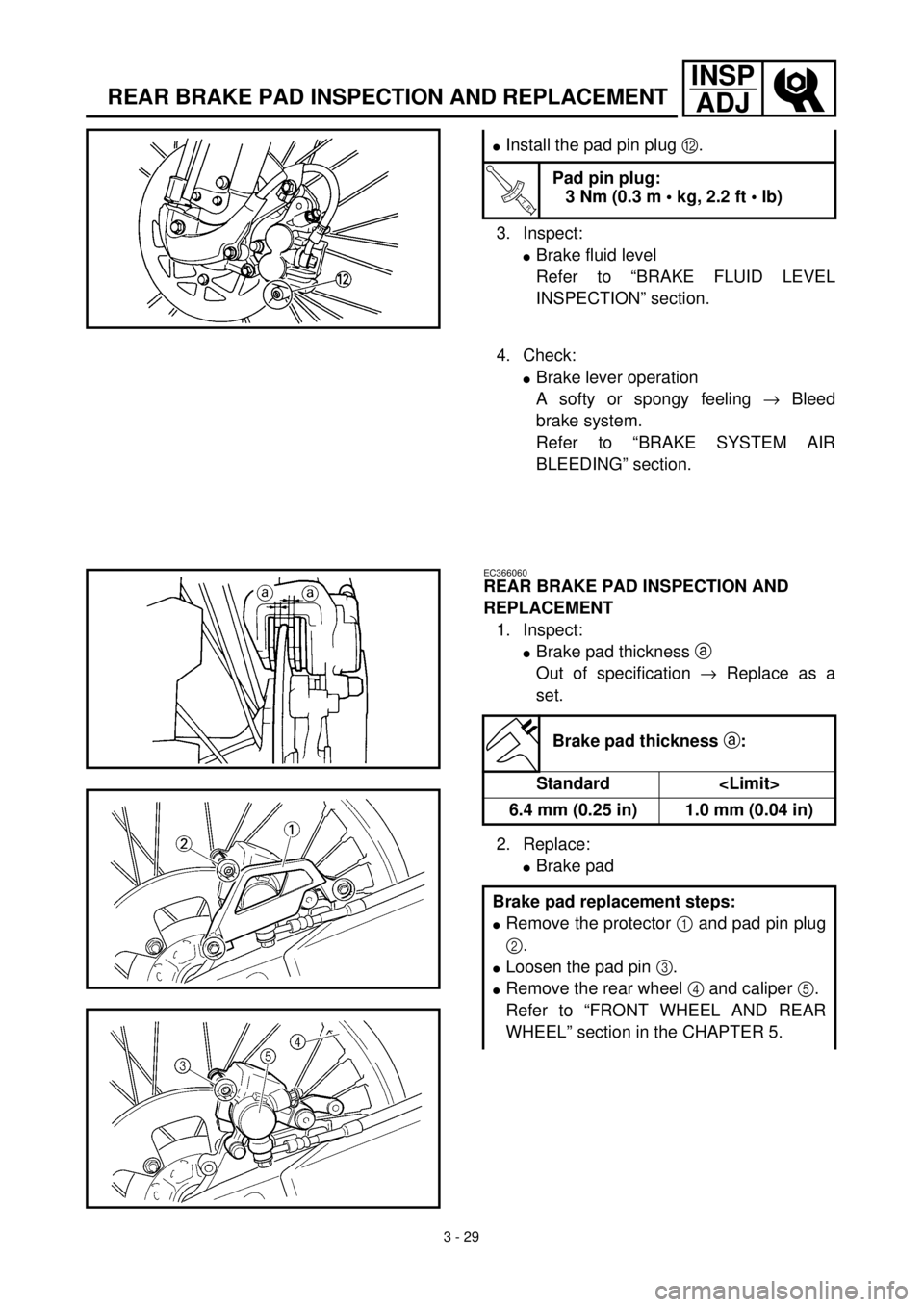
3 - 29
INSP
ADJ
REAR BRAKE PAD INSPECTION AND REPLACEMENT
3. Inspect:
lBrake fluid level
Refer to “BRAKE FLUID LEVEL
INSPECTION” section.
lInstall the pad pin plug B.
T R..
Pad pin plug:
3 Nm (0.3 m • kg, 2.2 ft • lb)
4. Check:
lBrake lever operation
A softy or spongy feeling ® Bleed
brake system.
Refer to “BRAKE SYSTEM AIR
BLEEDING” section.
EC366060
REAR BRAKE PAD INSPECTION AND
REPLACEMENT
1. Inspect:
lBrake pad thickness a
Out of specification ® Replace as a
set.
2. Replace:
lBrake pad
Brake pad thickness a:
Standard
6.4 mm (0.25 in) 1.0 mm (0.04 in)
Brake pad replacement steps:
lRemove the protector 1 and pad pin plug
2.
lLoosen the pad pin 3.
lRemove the rear wheel 4 and caliper 5.
Refer to “FRONT WHEEL AND REAR
WHEEL” section in the CHAPTER 5.
Page 224 of 654
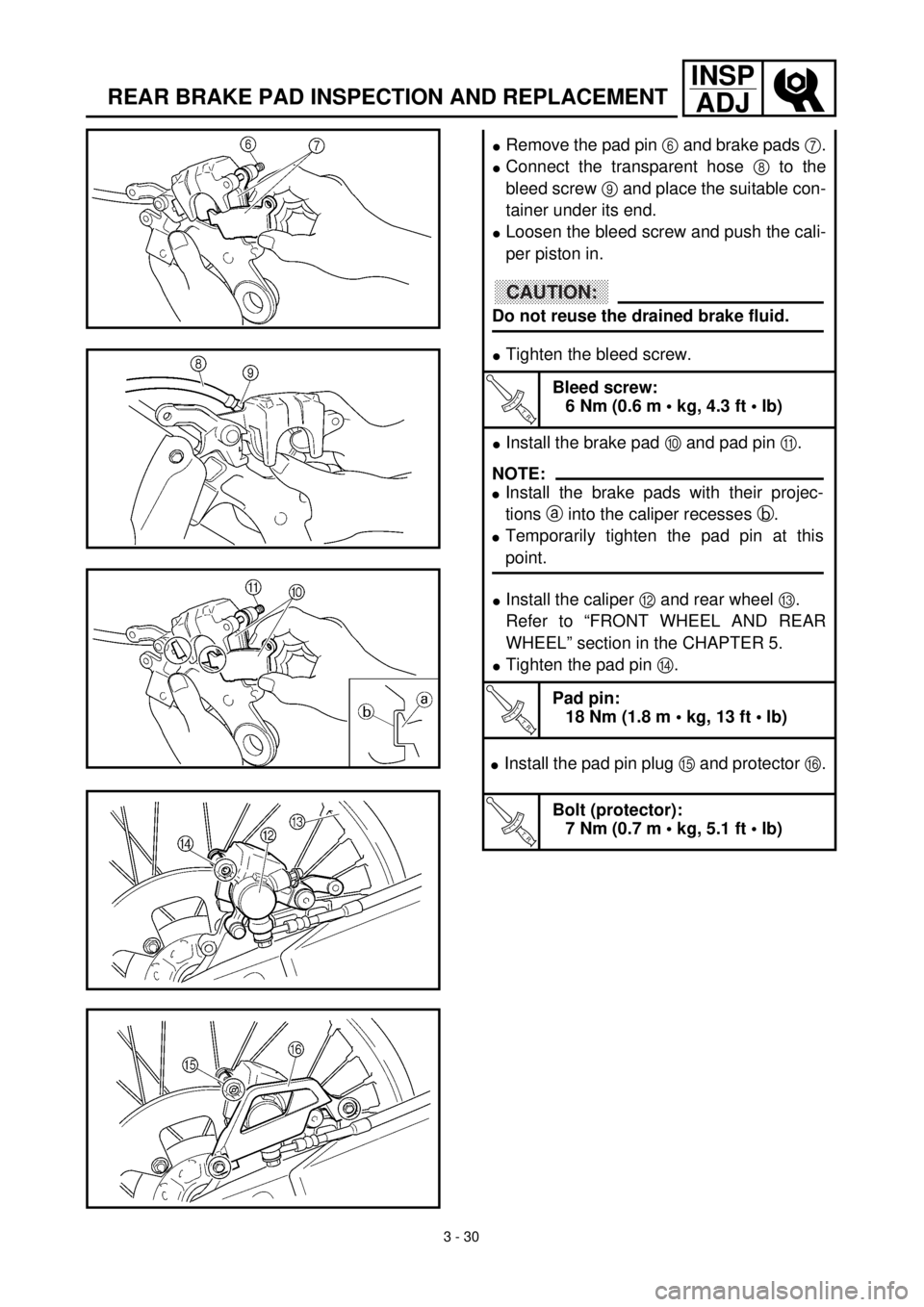
3 - 30
INSP
ADJ
REAR BRAKE PAD INSPECTION AND REPLACEMENT
lRemove the pad pin 6 and brake pads 7.
lConnect the transparent hose 8 to the
bleed screw 9 and place the suitable con-
tainer under its end.
lLoosen the bleed screw and push the cali-
per piston in.
lTighten the bleed screw.
T R..
Bleed screw:
6 Nm (0.6 m • kg, 4.3 ft • lb)
lInstall the brake pad 0 and pad pin A.
lInstall the caliper B and rear wheel C.
Refer to “FRONT WHEEL AND REAR
WHEEL” section in the CHAPTER 5.
lTighten the pad pin D.
T R..
Pad pin:
18 Nm (1.8 m • kg, 13 ft • lb)
lInstall the pad pin plug E and protector F.
T R..
Bolt (protector):
7 Nm (0.7 m • kg, 5.1 ft • lb)
CAUTION:
Do not reuse the drained brake fluid.
NOTE:
lInstall the brake pads with their projec-
tions a into the caliper recesses b.
lTemporarily tighten the pad pin at this
point.